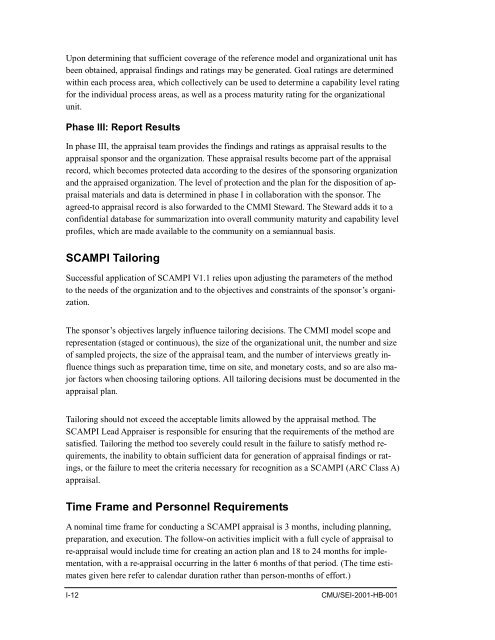Standard CMMI Appraisal Method for Process Improvement (SCAMPI)
Standard CMMI Appraisal Method for Process Improvement (SCAMPI)
Standard CMMI Appraisal Method for Process Improvement (SCAMPI)
Create successful ePaper yourself
Turn your PDF publications into a flip-book with our unique Google optimized e-Paper software.
Upon determining that sufficient coverage of the reference model and organizational unit has<br />
been obtained, appraisal findings and ratings may be generated. Goal ratings are determined<br />
within each process area, which collectively can be used to determine a capability level rating<br />
<strong>for</strong> the individual process areas, as well as a process maturity rating <strong>for</strong> the organizational<br />
unit.<br />
Phase III: Report Results<br />
In phase III, the appraisal team provides the findings and ratings as appraisal results to the<br />
appraisal sponsor and the organization. These appraisal results become part of the appraisal<br />
record, which becomes protected data according to the desires of the sponsoring organization<br />
and the appraised organization. The level of protection and the plan <strong>for</strong> the disposition of appraisal<br />
materials and data is determined in phase I in collaboration with the sponsor. The<br />
agreed-to appraisal record is also <strong>for</strong>warded to the <strong>CMMI</strong> Steward. The Steward adds it to a<br />
confidential database <strong>for</strong> summarization into overall community maturity and capability level<br />
profiles, which are made available to the community on a semiannual basis.<br />
<strong>SCAMPI</strong> Tailoring<br />
Successful application of <strong>SCAMPI</strong> V1.1 relies upon adjusting the parameters of the method<br />
to the needs of the organization and to the objectives and constraints of the sponsor’s organization.<br />
The sponsor’s objectives largely influence tailoring decisions. The <strong>CMMI</strong> model scope and<br />
representation (staged or continuous), the size of the organizational unit, the number and size<br />
of sampled projects, the size of the appraisal team, and the number of interviews greatly influence<br />
things such as preparation time, time on site, and monetary costs, and so are also major<br />
factors when choosing tailoring options. All tailoring decisions must be documented in the<br />
appraisal plan.<br />
Tailoring should not exceed the acceptable limits allowed by the appraisal method. The<br />
<strong>SCAMPI</strong> Lead Appraiser is responsible <strong>for</strong> ensuring that the requirements of the method are<br />
satisfied. Tailoring the method too severely could result in the failure to satisfy method requirements,<br />
the inability to obtain sufficient data <strong>for</strong> generation of appraisal findings or ratings,<br />
or the failure to meet the criteria necessary <strong>for</strong> recognition as a <strong>SCAMPI</strong> (ARC Class A)<br />
appraisal.<br />
Time Frame and Personnel Requirements<br />
A nominal time frame <strong>for</strong> conducting a <strong>SCAMPI</strong> appraisal is 3 months, including planning,<br />
preparation, and execution. The follow-on activities implicit with a full cycle of appraisal to<br />
re-appraisal would include time <strong>for</strong> creating an action plan and 18 to 24 months <strong>for</strong> implementation,<br />
with a re-appraisal occurring in the latter 6 months of that period. (The time estimates<br />
given here refer to calendar duration rather than person-months of ef<strong>for</strong>t.)<br />
I-12 CMU/SEI-2001-HB-001
















